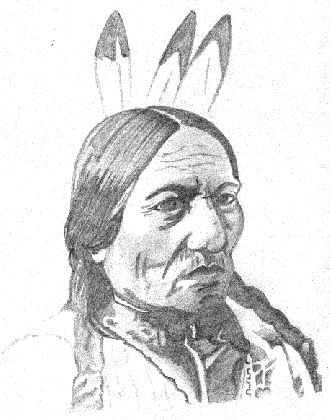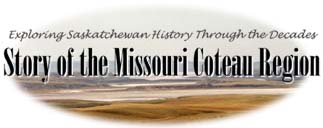|
|
 Sitting
Bull, a Sioux Indian was born in 1831 in South Dakota, USA. He was
one of the leaders of his buffalo-hunting tribe. He was also a medicine
man. During 1864, Sitting Bull led many attacks on the cavalry who
invaded their hunting territory. In 1874 gold was discovered it
the Black Hills of South Dakota. More white men came into the territory
to hunt for gold. US troops and scouts were trying to find these
Native people to place them on reserves. General George Custer,
one of the troop's leaders, trailed and caught up with the Aboriginal
people. Custer and his men tried to surround a small group of Indians.
What Custer didn't know was that 2,500 others were waiting near
by. Custer and his men were all killed. When a larger army moved
in some of the Natives surrendered. 5000 others followed Sitting
Bull to southern Saskatchewan near Fort Walsh in 1876. He was determined
not be placed on a reservation. For five years, Sitting Bull and
his tribe roamed over the southern parts of Saskatchewan hunting
buffalo and other game. After five years food became scarce, trouble
was brewing between the Sioux and Canadian Aboriginals. Sitting
Bull traveled to Moose Jaw and Qu'Appelle searching for a place
to stay. A French trader, Louis Legare and a good friend of Sitting
Bull helped supply the Native people during the winter months. He
finally influenced them to return to the USA. He promised to make
arrangements with their government. On July 10, 1881, Sitting Bull
and 500 Remaining Sioux began the 90 mile trek to Fort Buford (now
North Dakota). On July 21, the tribe was taken to a reservation
in Minnesota. Sitting Bull lived there for the next few years, but
was suspected of having some influence on the disturbances that
were starting. He was shot in 1890 when he resisted arrest. He was
buried in Minnesota. Sitting
Bull, a Sioux Indian was born in 1831 in South Dakota, USA. He was
one of the leaders of his buffalo-hunting tribe. He was also a medicine
man. During 1864, Sitting Bull led many attacks on the cavalry who
invaded their hunting territory. In 1874 gold was discovered it
the Black Hills of South Dakota. More white men came into the territory
to hunt for gold. US troops and scouts were trying to find these
Native people to place them on reserves. General George Custer,
one of the troop's leaders, trailed and caught up with the Aboriginal
people. Custer and his men tried to surround a small group of Indians.
What Custer didn't know was that 2,500 others were waiting near
by. Custer and his men were all killed. When a larger army moved
in some of the Natives surrendered. 5000 others followed Sitting
Bull to southern Saskatchewan near Fort Walsh in 1876. He was determined
not be placed on a reservation. For five years, Sitting Bull and
his tribe roamed over the southern parts of Saskatchewan hunting
buffalo and other game. After five years food became scarce, trouble
was brewing between the Sioux and Canadian Aboriginals. Sitting
Bull traveled to Moose Jaw and Qu'Appelle searching for a place
to stay. A French trader, Louis Legare and a good friend of Sitting
Bull helped supply the Native people during the winter months. He
finally influenced them to return to the USA. He promised to make
arrangements with their government. On July 10, 1881, Sitting Bull
and 500 Remaining Sioux began the 90 mile trek to Fort Buford (now
North Dakota). On July 21, the tribe was taken to a reservation
in Minnesota. Sitting Bull lived there for the next few years, but
was suspected of having some influence on the disturbances that
were starting. He was shot in 1890 when he resisted arrest. He was
buried in Minnesota.


|
